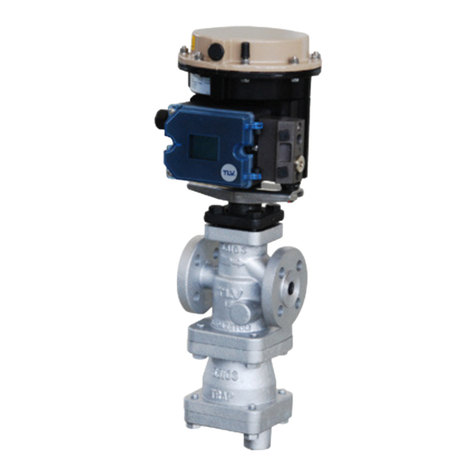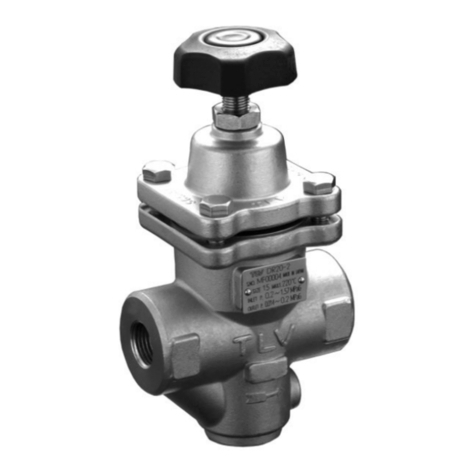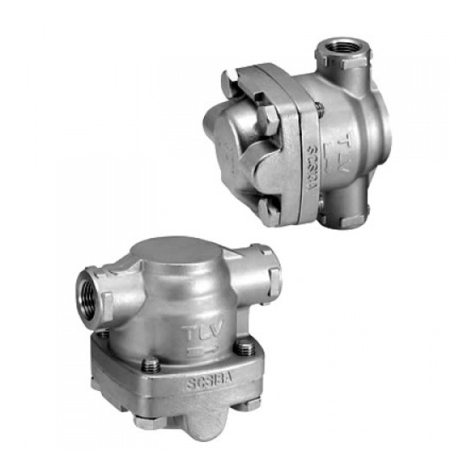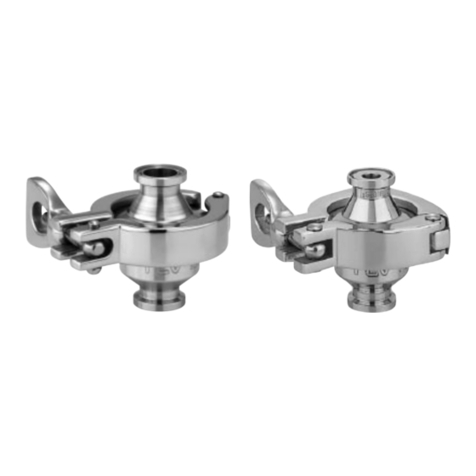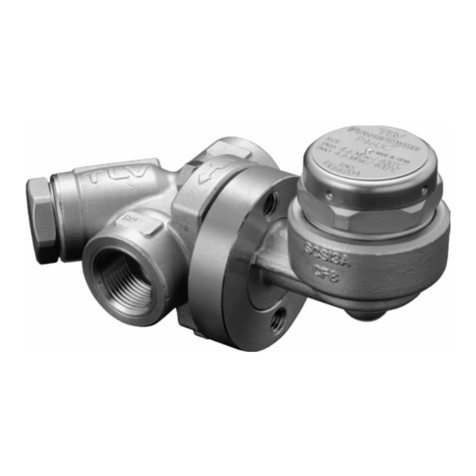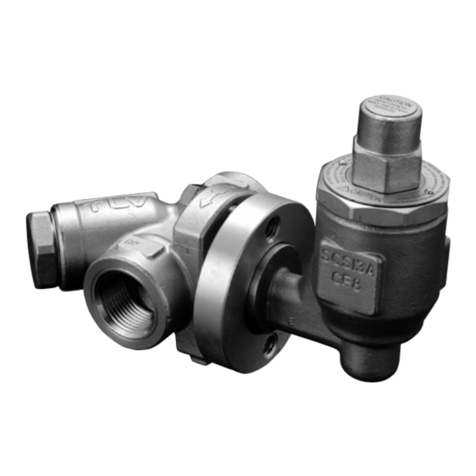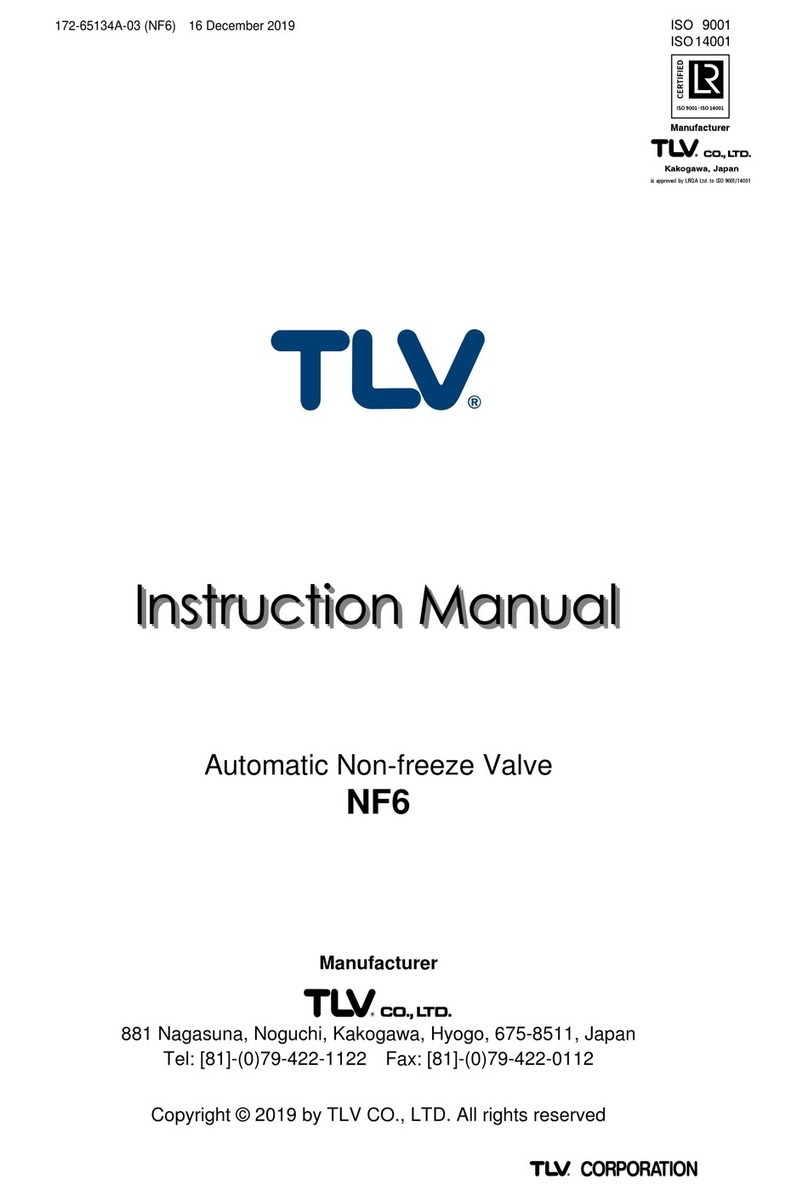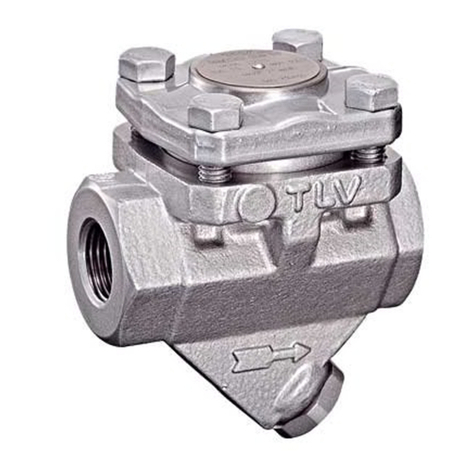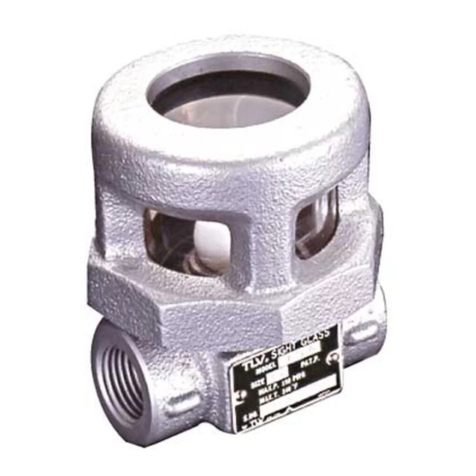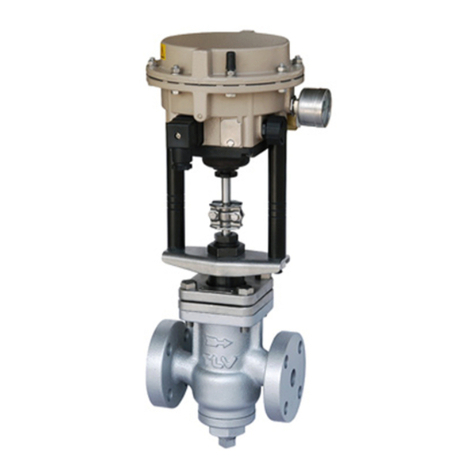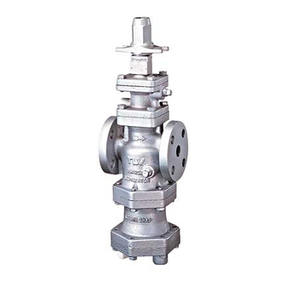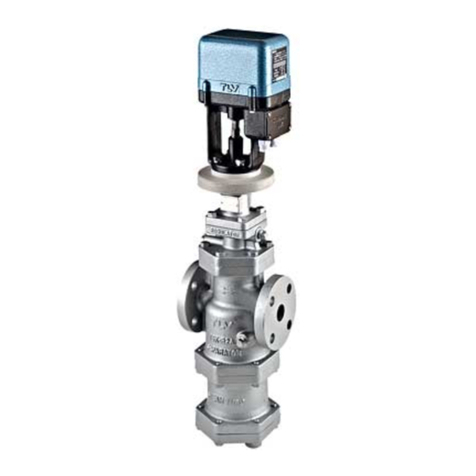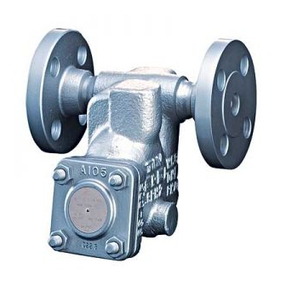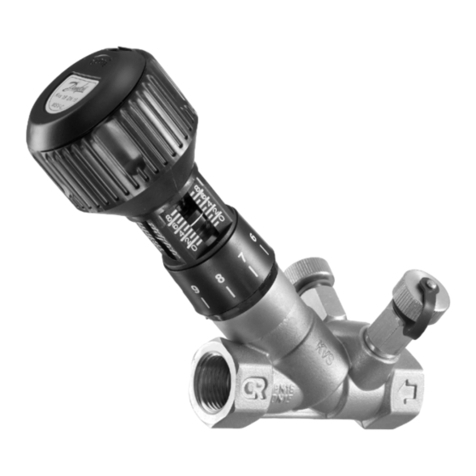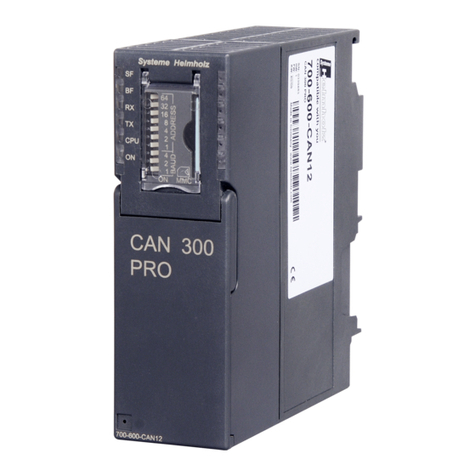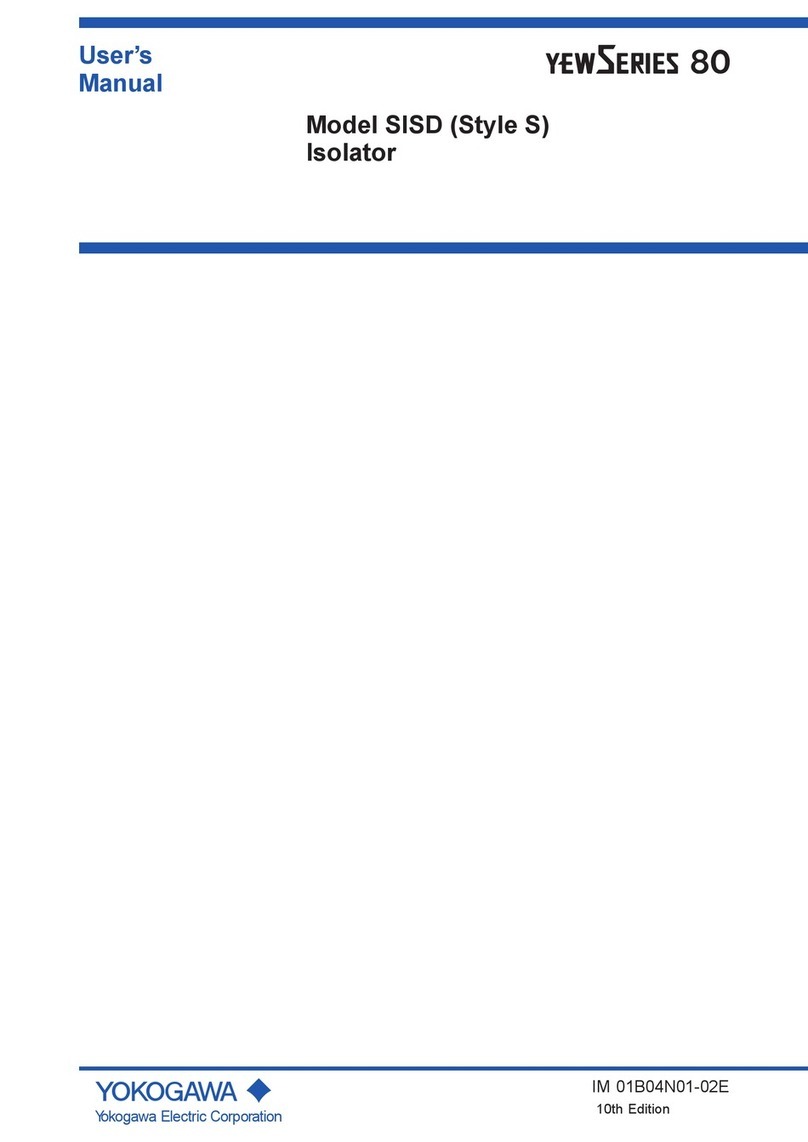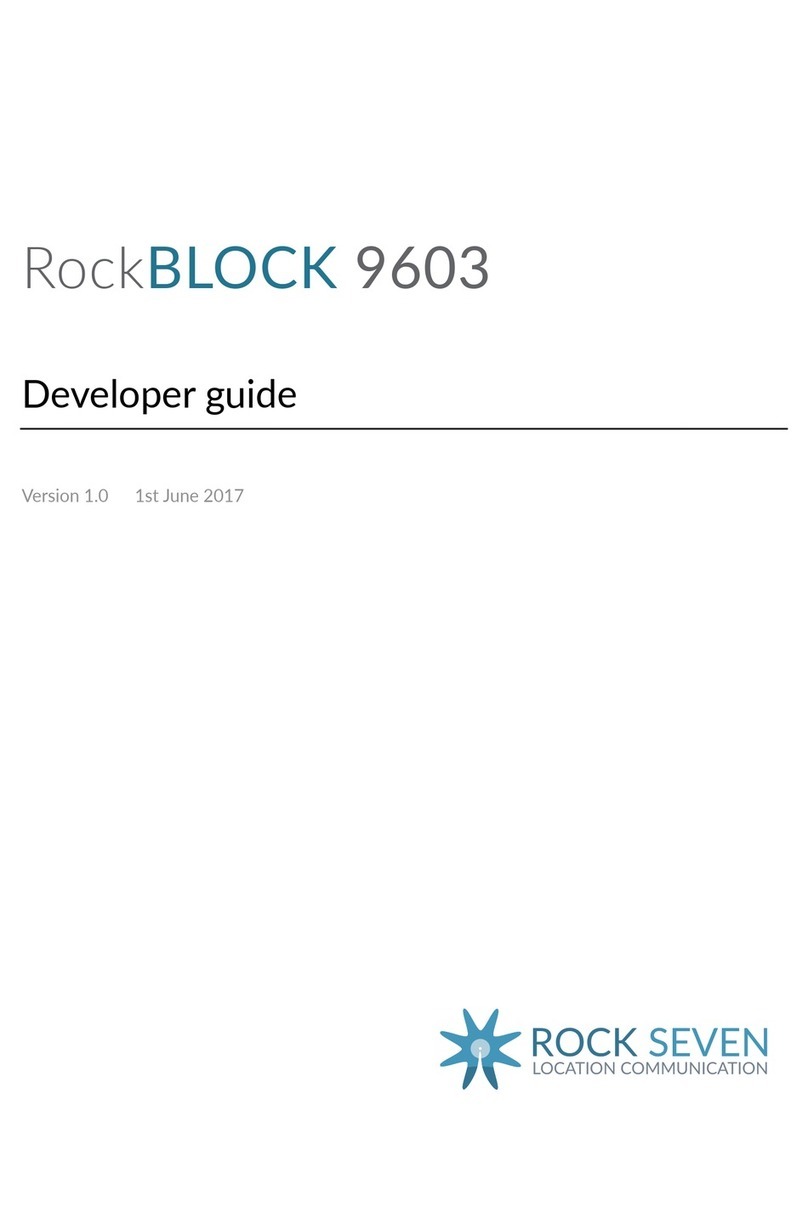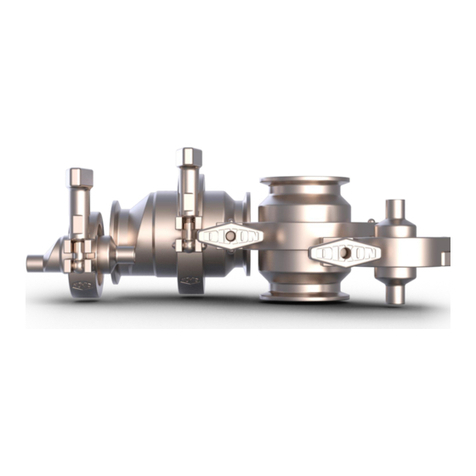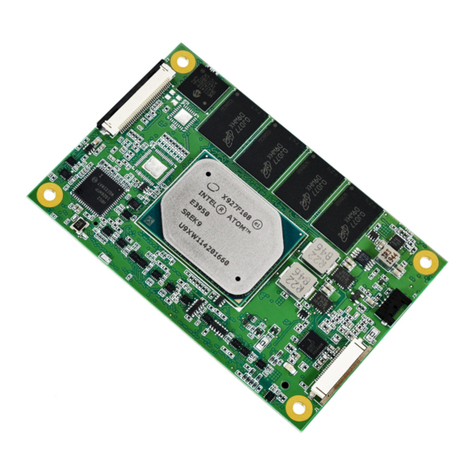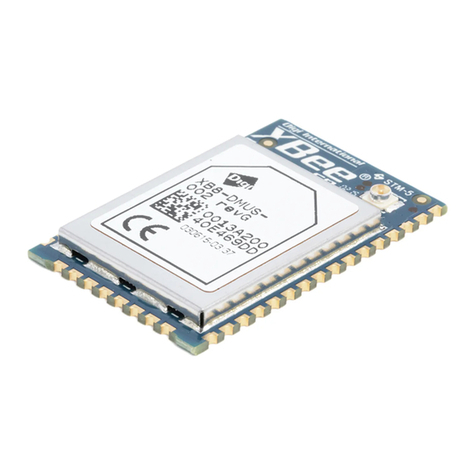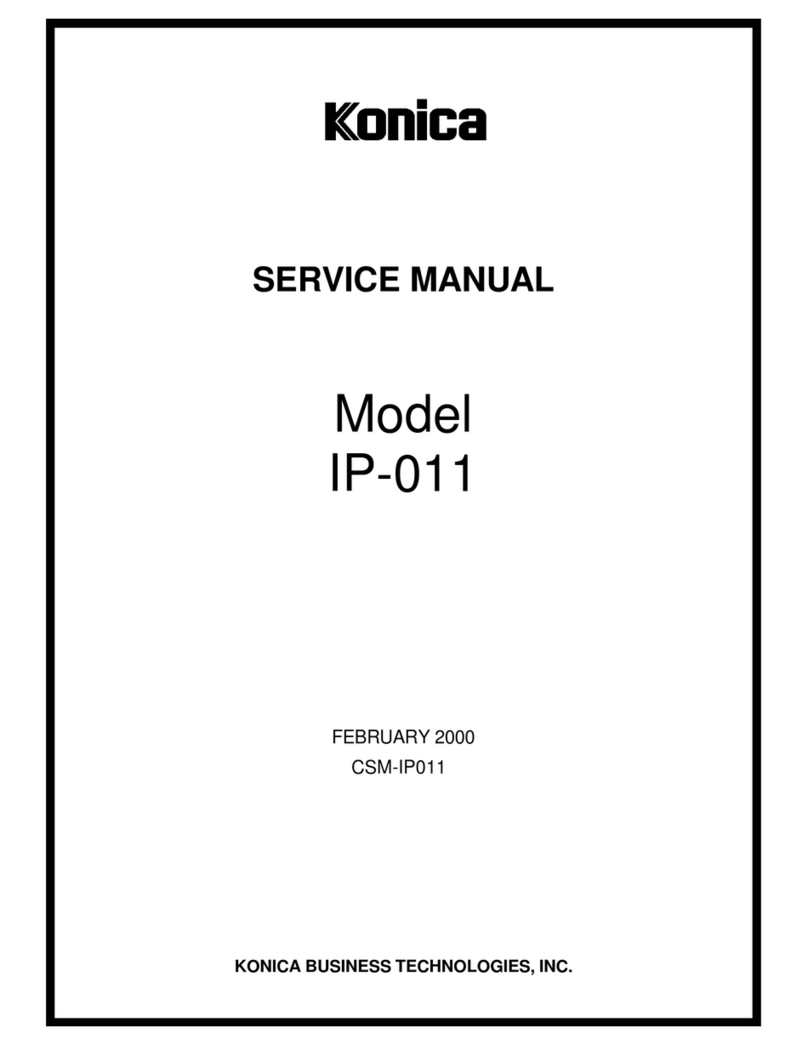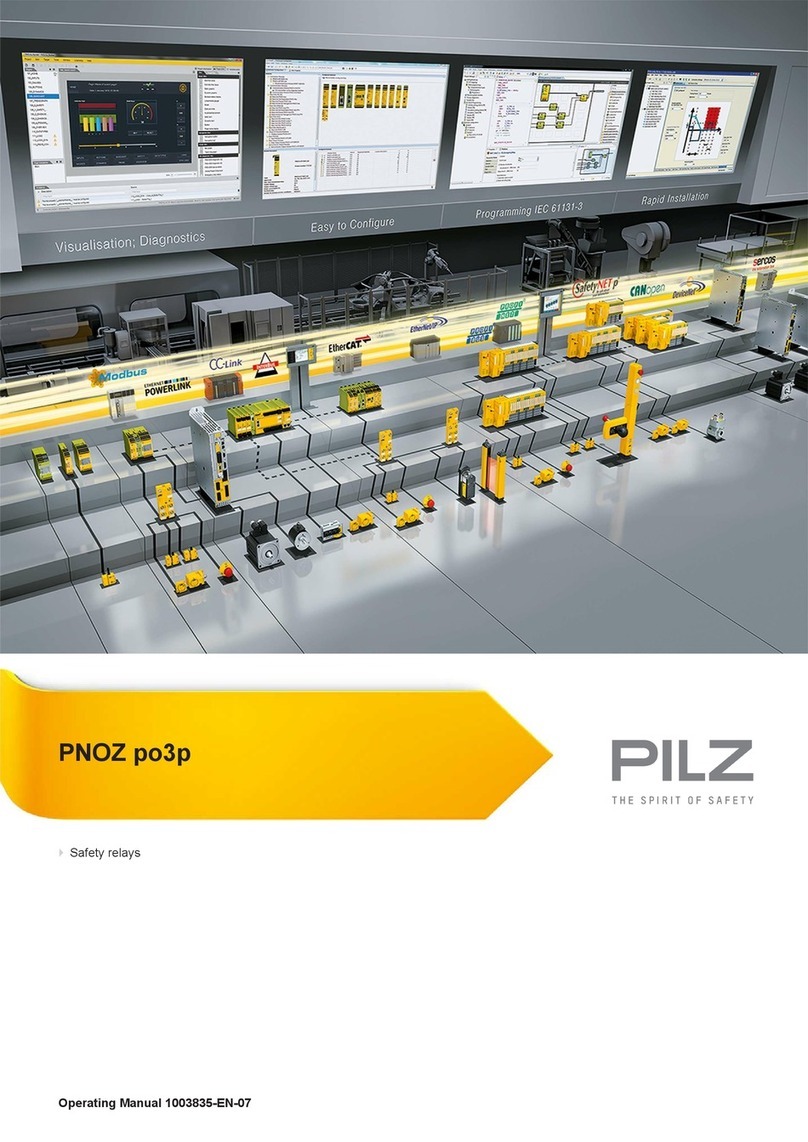TLV DR8-3P User manual

172-65613A-03 (DR8-3P/DR8-3EP/DR8-6P/DR8-6EP) 11 June 2020
Manufacturer
881 Nagasuna, Noguchi, Kakogawa, Hyogo, 675-8511, Japan
Tel: [81]-(0)79-422-1122 Fax: [81]-(0)79-422-0112
Copyright © 2020 by TLV CO., LTD. All rights reserved
Clean Steam Direct-acting Pressure Reducing Valve
DR8-3P / DR8-3EP
DR8-6P / DR8-6EP

172-65613A-03 (DR8-3P/DR8-3EP/DR8-6P/DR8-6EP) 11 Jun 2020
1
Contents
Introduction .......................................................................1
Safety Considerations.......................................................2
Specifications....................................................................4
Acceptable Operating Range............................................4
Correct Usage of the DR8 Direct-acting Pressure
Reducing Valve.................................................................5
Configuration.....................................................................7
Installation.........................................................................8
Adjustment ......................................................................11
Maintenance....................................................................12
Disassembly....................................................................13
Reassembly ....................................................................18
Troubleshooting ..............................................................19
EXPRESS LIMITED WARRANTY..........................21
Introduction
Thank you for purchasing the TLV DR8 clean steam direct-acting pressure
reducing valve.
This product has been thoroughly inspected before being shipped from the
factory. When the product is delivered, before doing anything else, check
the specifications and external appearance to make sure nothing is out of
the ordinary. Also be sure to read this manual carefully before use and
follow the instructions to be sure of using the product properly.
The TLV DR8 clean steam direct-acting pressure reducing valve has been
developed especially for the food, beverage and pharmaceutical
industries. This product has an angle type structure with special polishing
applied to internal parts to minimize areas for condensate to accumulate,
and prevent contamination inside the product. Additionally this product has
a structure that is easily disassembled to make internal cleaning
convenient.
For products with special order specifications or options, if detailed
instructions for the special order specifications or options are not
contained in this manual, please contact TLV for full details.
This instruction manual is intended for use with the model(s) listed on the
front cover. It is necessary not only for installation but for subsequent
maintenance, disassembly/reassembly and troubleshooting. Please keep it
in a safe place for future reference.

172-65613A-03 (DR8-3P/DR8-3EP/DR8-6P/DR8-6EP) 11 Jun 2020
2
Safety Considerations
Read this section carefully before use and be sure to follow the
instructions.
Installation, inspection, maintenance, repairs, disassembly, adjustment
and valve opening/closing should be carried out only by trained
maintenance personnel.
The precautions listed in this manual are designed to ensure safety and
prevent equipment damage and personal injury. For situations that may
occur as a result of erroneous handling, three different types of
cautionary items are used to indicate the degree of urgency and the
scale of potential damage and danger: DANGER, WARNING and
CAUTION.
The three types of cautionary items above are very important for safety:
be sure to observe all of them as they relate to installation, use,
maintenance, and repair. Furthermore, TLV accepts no responsibility
for any accidents or damage occurring as a result of failure to observe
these precautions.
Symbols
Indicates a DANGER, WARNING or CAUTION item.
DANGER
Indicates an urgent situation which poses a threat of death or
serious injury
WARNING
Indicates that there is a potential threat of death or serious
injury
CAUTION
Indicates that there is a possibility of injury or
equipment/product damage
CAUTION
Install properly and DO NOT use this product outside the
recommended operating pressure, temperature and other
specification ranges.
Improper use may result in such hazards as damage to the
product or malfunctions that may lead to serious accidents.
Local regulations may restrict the use of this product to below
the conditions quoted.
Take measures to prevent people from coming into direct
contact with product outlets.
Failure to do so may result in burns or other injury from the
discharge of fluids.
When disassembling or removing the product, wait until
the internal pressure equals atmospheric pressure and the
surface of the product has cooled to room temperature.
Disassembling or removing the product when it is hot or under
pressure may lead to discharge of fluids, causing burns, other
injuries or damage.
Continued on the next page

172-65613A-03 (DR8-3P/DR8-3EP/DR8-6P/DR8-6EP) 11 Jun 2020
3
CAUTION
Be sure to use only the recommended components when
repairing the product, and NEVER attempt to modify the
product in any way.
Failure to observe these precautions may result in damage to
the product and burns or other injury due to malfunction or the
discharge of fluids.
Use only under conditions in which no freeze-up will occur.
Freezing may damage the product, leading to fluid discharge,
which may cause burns or other injury.
Use only under conditions in which no water hammer will
occur.
The impact of water hammer may damage the product, leading
to fluid discharge, which may cause burns or other injury.

172-65613A-03 (DR8-3P/DR8-3EP/DR8-6P/DR8-6EP) 11 Jun 2020
4
Specifications
Install properly and DO NOT use this product outside the recommended
operating pressure, temperature and other specification ranges.
Improper use may result in such hazards as damage to the product or
malfunctions which may lead to serious accidents. Local regulations
may restrict the use of this product to below the conditions quoted.
CAUTION
Use only under conditions in which no freeze-up will occur. Freezing
may damage the product, leading to fluid discharge, which may cause
burns or other injury.
CAUTION
Refer to the indications on the spring housing for detailed specifications.
Connection Standard No.
CNo.**
Production
Lot No.
Inner Diameter
Primary Pressure Range
Secondary Pressure Adjustable Range
Connection Standard
Nominal Diameter
Maximum Allowable
Pressure/Temperature*
Maximum Operating
Pressure/Temperature
Model
*Maximum allowable pressure (PMA) and maximum
allowable temperature (TMA) are PRESSURE SHELL
DESIGN CONDITIONS, NOT OPERATING CONDITIONS.
**CNo. (Charge/Mill No.) is displayed for products with
options. This item is omitted when there are no options.
Acceptable Operating Range
Model
DR8-3P/DR8-3EP
DR8-6P/DR8-6EP
Primary Pressure Range
0.2 to 0.4 MPaG
(30 to 60 psig)
0.4 to 0.8 MPaG
(60 to 115 psig)
Adjustable Pressure Range
0.018 to 0.3 MPaG
(2.5 to 45 psig)
0.27 to 0.6 MPaG
(40 to 85 psig)
No more than a maximum of 75% of the primary pressure
(1MPa = 10.197 kg/cm2)

172-65613A-03 (DR8-3P/DR8-3EP/DR8-6P/DR8-6EP) 11 Jun 2020
5
Correct Usage of the DR8 Direct-acting Pressure
Reducing Valve
Install properly and DO NOT use this product outside the recommended
operating pressure, temperature and other specification ranges.
Improper use may result in such hazards as damage to the product or
malfunctions which may lead to serious accidents. Local regulations
may restrict the use of this product to below the conditions quoted.
CAUTION
1. The DR8 should be operated only within its specifications.
2. Installing an ON/OFF valve (solenoid valve or motorized valve)
Motorized
Valve
DR-8
Inlet Side Steam
Trap
DR-8 Motorized
Valve
Outlet Side
Steam
Trap
If an on-off valve, such as a motorized valve, is required to stop supply of
steam to the steam-using equipment, install it at the inlet side of the DR8. If a
solenoid valve is installed at the outlet of the DR8, it will cause heavy
chattering and may lead to damage of the DR8. (When the on-off valve opens,
the secondary pressure of the DR8 changes from zero to the set pressure,
passing through an area of the reducing ratio of less than 30:1, where
adjustment is impossible, chattering occurs momentarily.) To save energy, it is
recommended to install the on-off valve as near to the boiler, as possible.
NOTE: To prevent water hammer, it is recommended that a slow-acting
motorized on-off valve be used. In particular, if a fast-acting on-off
solenoid valve is used for frequent temperature control, the potential
water hammer effect can damage the steam-using equipment and the
DR8.
3. Installing a control and/or safety valve
Steam-using
Equipment
Safety
(Relief)
Valve
Control
Valve
DR-8
Steam
Trap
Steam
Trap
Inlet
Valve
Outlet
Valve
Pressure
Gauge
Safety
(Relief)
Valve Control
Valve
DR-8 Steam-using
Equipment
Steam
Trap
Steam
Trap
Inlet
Valve
Outlet
Valve
Pressure
Gauge
A control valve (i.e. for temperature control) installed between the DR8 and
the steam-using equipment (downstream of the DR8) may raise the pressure
between the DR8 and the control valve when the control valve is closed,
depending on the spatial relationship. Therefore, a safety valve should be
installed downstream of the control valve.
NOTE: When installing a safety valve to protect steam-using equipment, be
sure to install it on, or directly before, the inlet of the steam-using
equipment. If the safety valve is installed between the DR8 and a
control valve, an eventual pressure rise could activate the safety valve.

172-65613A-03 (DR8-3P/DR8-3EP/DR8-6P/DR8-6EP) 11 Jun 2020
6
4. Precautions for the installation of additional fittings before or after the DR8
In order to ensure a stable steam flow, the piping upstream and downstream
of the DR8must be in straight runs. If the DR8 is installed either directly
before or after an elbow or control valve, unevenness in steam flow may result
in chattering and unstable pressure.
To ensure a stable steam flow, it is recommended that the DR8be installed on
straight runs of piping, as illustrated below.
①Inlet (primary side) of the pressure reducing valve (NOTE: d = pipe diameter)
Maintain a straight piping
run of 10 d or more when a
manual valve, a strainer or
an elbow, etc. is installed.
(Example: if nominal size is
25 mm (1 in), have 250 mm
(10 in) or more)
Valve, Strainer,
Elbow, etc.
10 d or more
DR8
Valve, Strainer,
Elbow, etc.
10 d or more
DR8
Steam
Trap
Less than
10 d
Valve, Strainer,
Elbow, etc. DR8
Less than
10 d
Valve, Strainer,
Elbow, etc. DR8
Steam
Trap
Maintain a straight piping
run of 30 d or more when
an automatic valve (on-off
valve) is installed.
(Example: if nominal size is
25 mm (1 in), have 750
mm (30 in) or more)
30 d or more
DR8
Automatic
Valve
30 d or more
DR8
Automatic
Valve
Steam
Trap
Less than
30 d
DR8
Automatic
Valve
Less than
30 d
DR8
Automatic
Valve
Steam
Trap
②Outlet (secondary side) of the pressure reducing valve
Maintain a straight piping
run of 15 d or more when
a manual valve, a strainer
or an elbow, etc. is
installed.
(Example: if nominal size is
25 mm (1 in), have 375
mm (15 in) or more)
15 d or more
DR8 Valve, Strainer,
Elbow, etc.
15 d or more
DR8 Valve, Strainer,
Elbow, etc.
Steam
Trap
Less than
15 d
DR8 Valve, Strainer,
Elbow, etc.
Less than
15 d
DR8 Valve, Strainer,
Elbow, etc.
Steam
Trap
Maintain a straight piping
run of 30 d or more when
a safetyvalve is installed.
(Example: if nominal size is
25 mm (1 in), have 750
mm (30 in) or more)
30 d or more
DR8
Safety
(Relief)
Valve
30 d or more
DR8
Safety
(Relief)
Valve
Steam
Trap
Less than
30 d
DR8
Safety
(Relief)
Valve
Less than
30 d
DR8
Safety
(Relief)
Valve
Steam
Trap
Maintain a straight piping
run of 30 d or more when
another pressure reducing
valve is installed. (Two-
stage pressure reduction)
(Example: if nominal size is
25 mm (1 in), have 750
mm (30 in) or more)
30 d or more
DR8 Second
Pressure
Reducing
Valve
Steam
Trap
Less than
30 d
DR8
Steam
Trap
Second
Pressure
Reducing
Valve

172-65613A-03 (DR8-3P/DR8-3EP/DR8-6P/DR8-6EP) 11 Jun 2020
7
Configuration
Size 40 mm
No.
Name
A*1
B*1
C*1
1
Body
2
Valve
3
Diaphragm
4
Protective Sheet
5
Spring Housing
6
Upper Diaphragm
Retainer
7
Coil Spring*2
8
Cap
9
Lower Diaphragm
Retainer
10
Plain Washer
11
Spring Washer
12
High Nut
13
Spring Retainer*2
14
Retainer Gasket
15
Locknut
16
Adjustment Screw
17
Valve Guide
18
Inlet Clamp Gasket*3
19
Snap Ring
20
Slide Bearing
21
Body Clamp
22
Body Clamp Bolt*4
23
Body Clamp Nut*4
24
Spring Washer*4
25
Inlet Clamp*4
26
Inlet Clamp Bolt*5
27
Inlet Clamp Nut*5
28
Spring Washer*5
29
Adapter*6
30
Coil Spring Guide
*1 Replacement parts are available
only in the following kits:
A: Maintenance Kit
B: Repair Kit for Diaphragm/Valve
C: Repair Kit for Valve Guide
*2 The spring retainer and coil spring
guide cannot be removed
individually as they are incorporated
with the coil spring.
*3 Number of parts for sizes 15 to 20
mm (1/2to 3/4in): 2 pieces, 25 mm (1
in): 1 piece
*4 Number of parts: 2 pieces
*5 Number of parts for sizes 15 to 20
mm (1/2to 3/4in): 4 pieces, 25 mm
(1 in): 2 pieces
*6 For sizes 15 to 20 mm (1/2to 3/4in)
only
Sizes 15 to 20 mm
Size 25 mm

172-65613A-03 (DR8-3P/DR8-3EP/DR8-6P/DR8-6EP) 11 Jun 2020
8
Installation
Install properly and DO NOT use this product outside the recommended
operating pressure, temperature and other specification ranges.
Improper use may result in such hazards as damage to the product or
malfunctions which may lead to serious accidents. Local regulations
may restrict the use of this product to below the conditions quoted.
CAUTION
Take measures to prevent people from coming into direct contact with
product outlets. Failure to do so may result in burns or other injury from
the discharge of fluids.
CAUTION
Installation, inspection, maintenance, repairs, disassembly, adjustment and valve
opening/closing should be carried out only by trained maintenance personnel.
1. Removing the Protective Caps
Before installation, be sure to remove all protective seals and caps
covering the product inlet and outlets. (Found in 2 locations)
2. Tolerance Angle for Installation
Make sure the DR8 is installed vertically so that the arrow mark on
the body matches the direction of steam flow, the outlet is
horizontal, and the adjustment screw section faces up.
Allowable inclination is 10 degrees in the fore-aft direction
and 15 degrees side to side in the plane perpendicular to
the steam flow line.
3. Piping Support
Install the DR8, paying attention to avoid excessive load, bending and
vibration. It is recommended that the inlet and
outlet pipes be supported securely.
4. Maintenance Space
Leave sufficient space for maintenance,
inspection and repair.
A: 260 mm (101/4in)
B: 110 mm (41/2in)
A
BB
DR-8
Piping
Support
Piping
Support

172-65613A-03 (DR8-3P/DR8-3EP/DR8-6P/DR8-6EP) 11 Jun 2020
9
5. Piping Size
If the secondary steam flow velocity is expected to be more than 30 m/s (100
ft/s), install a diffuser in order to keep the flow velocity below 30 m/s (100 ft/s).
If the distance between the DR8 and the steam-using equipment is great, a
possible drop in pressure should be taken into consideration when selecting
the piping size.
Diffuser
DR8
Straight piping: 10d or longer for
primary side,15d or longer for
secondary side (d=pipe diameter)
DR8
Primary
Side
Secondary
Side
Pressure
Gauge
Inlet
Valve
Bypass Valve Safety Valve
(Relief Valve)
Outlet
Valve Pressure
Gauge
Steam
Trap
Bypass Valve
Secondary
Side
Safety Valve
(Relief Valve)
Outlet
Valve Pressure
Gauge
Primary
Side Pressure
Gauge
Inlet
Valve
Steam
Trap
6. Two-stage Pressure Reduction
Employ 2-stage pressure reduction if the required reduction is not possible due
to DR8 operating range limitations (when it is not possible to reduce to the
desired pressure using a single pressure reducing valve).
DR8
Pressure
Gauge
Inlet
Valve Outlet
Valve Pressure
Gauge Inlet
Valve
Bypass Valve
Bypass Valve Safety Valve
(Relief Valve)
Outlet
Valve
Primary
Side
Secondary
Side
Bypass Valve
Inlet
Valve
Outlet
Valve
Pressure
Gauge
Pressure
Gauge
Pressure
Gauge
Steam Trap Steam Trap
Secondary
Side
Steam Trap
Primary
Side
Safety Valve
(Relief Valve)
Pressure
Reducing
Valve
Pressure
Reducing
Valve

172-65613A-03 (DR8-3P/DR8-3EP/DR8-6P/DR8-6EP) 11 Jun 2020
10
7. Accessories
Always install a bypass line. At the inlet and outlet, install a pressure gauge
and a shut-off valve. Ball valves, which will not retain condensate, are
recommended for inlet/outlet shut-off valves. The nominal pipe size for the
bypass line should be 1/2or greater of the primary pipe size.
DR8
Pressure
Gauge
Inlet
Valve
Safety Valve
(Relief Valve)
Primary
Side
Secondary
Side
Ball
Valve
Bypass Valve
Pressure
Gauge
Outlet
Valve
Ball
Valve Steam Trap
8. Blowdown (Installing the bypass valve)
Before installing the DR8 or supplying steam to the DR8, be sure to blow down
all piping thoroughly. Installing the bypass valve makes blowdown easier.
Blowdown is especially important for newly installed piping or after the system
has been shut down for a long period of time. This will reduce operation failure
caused by condensate or foreign matter. The bypass valve should not be
opened too quickly. If a safety valve (or relief valve) is installed, perform
blowdown staying clear of pressurized blow-out.
If condensate accumulates while the inlet valve is closed, install a steam trap
that has a sufficient discharge capacity considering the initial condensate
discharge amount.
To perform blowdown, close the inlet valve (A) first, then the outlet valve (B), and
open the bypass valve (C). Do not open valves too quickly.
Pressure
Gauge
Steam
Trap
Steam
Trap
Safety (Relief)
Valve
DR-8
Inlet Valve
(A)
Bypass Valve
(C)
Outlet Valve
(B)
Pressure
Gauge
Primary
Side
Secondary
Side

172-65613A-03 (DR8-3P/DR8-3EP/DR8-6P/DR8-6EP) 11 Jun 2020
11
Adjustment
Use only under conditions in which no water hammer will occur. The
impact of water hammer may damage the product, leading to fluid
discharge, which may cause burns or other injury.
CAUTION
To avoid problems such as water hammer and to protect steam-using equipment,
the DR8 should be correctly adjusted.
1. It is necessary to blow down all pipe lines thoroughly. The blowdown is
especially important if the line is new or has been shut down for a long period
of time. Take particular care to ensure that matter such as condensate and dirt
does not remain inside the steam-using equipment.
(Stay clear of any pressurized blow-out from the safety valve.)
2. Make sure that the shut-off and bypass valves located upstream and
downstream of the DR8 are completely closed.
3. Remove the cap and loosen the locknut, then turn the adjustment screw
counterclockwise to free the coil spring.
4. Slowly, fully open the shut-off valve at the inlet of the DR8.
5. Slightly open the shut-off valve at the outlet of the DR8.
6. Turn the adjustment screw clockwise until the desired outlet pressure is
obtained. Wait several minutes.
Clockwise Counter-
clockwise
Increase Pressure Decrease Pressure
7. Slowly, fully open the shut-off valve at the outlet of the DR8.
8. After setting, hold the adjustment screw and retighten the locknut.
9. When shutting down the system, always close the outlet shut-off valve first and
then the inlet valve. (If the inlet shut-off valve is closed first, the safety valve
may be tripped.)

172-65613A-03 (DR8-3P/DR8-3EP/DR8-6P/DR8-6EP) 11 Jun 2020
12
Maintenance
Take measures to prevent people from coming into direct contact with
product outlets. Failure to do so may result in burns or other injury from
the discharge of fluids.
CAUTION
Be sure to use only the recommended components when repairing the
product, and NEVER attempt to modify the product in any way. Failure to
observe these precautions may result in damage to the product or burns
or other injury due to malfunction or the discharge of fluids.
CAUTION
Parts Inspection
When parts have been removed, or during periodic inspections, use the following
table to inspect the parts and replace any that are found to be defective.
Part
Inspection and Maintenance Frequency
Diaphragm,
Protective Sheet
If hunting or chattering takes place, cracks or fatigue may develop in
a short period of time.
Valve, Body
If there is chattering or dirt, premature wear may result.
Valve Guide,
(Slide Bearing)
If hunting or chattering takes place, premature wear may result.

172-65613A-03 (DR8-3P/DR8-3EP/DR8-6P/DR8-6EP) 11 Jun 2020
13
Disassembly
When disassembling or removing the product, wait until the internal
pressure equals atmospheric pressure and the surface of the product
has cooled to room temperature. Disassembling or removing the
product when it is hot or under pressure may lead to discharge of fluids,
causing burns, other injuries or damage.
CAUTION
It is a recommended practice to dismantle and inspect the DR8 once a year for
preventive maintenance purposes. It is especially important to perform an
inspection immediately after the initial run of a new line or before or after
equipment such as a heater is out of service for a long period of time.
(Installation, inspection, maintenance, repairs, disassembly, adjustment and valve
opening/closing should be carried out only by trained maintenance personnel.)
Remove all steam from the piping (both upstream and downstream).
Wait for the body to cool before attempting to remove the DR8 from the line.
Then remove the DR8 from the piping, and secure it in a vise to perform the
inspection.
Disassembling the Adjustment Section
Loosen the cap and the locknut first. Loosen the adjustment screw completely
and remove the body clamp.

172-65613A-03 (DR8-3P/DR8-3EP/DR8-6P/DR8-6EP) 11 Jun 2020
14
After removing the spring housing, loosen the spring retainer by turning it
counterclockwise
Check for seizure or any damaged screw threads.
NOTE: The spring retainer and coil spring guide cannot be removed individually as they
are incorporated with the coil spring.
Disassembling the Diaphragm Section
Hold the valve in place with an adjustable wrench across the flats on the upper
part of the valve and use another wrench to remove the high nut. After removing
the high nut, remove the plain washer, the upper diaphragm retainer and the
diaphragm.

172-65613A-03 (DR8-3P/DR8-3EP/DR8-6P/DR8-6EP) 11 Jun 2020
15
Disassembling the Valve Section
Remove the inlet clamp(s) holding the body, valve guide and adapter (for sizes
15 to 20 mm (1/2to 3/4in) only).
Remove the adapter and the inlet clamp gasket.
(for sizes 15 to 20 mm (1/2to 3/4in) only)
Separate the valve guide from the body. The valve comes off with the valve guide.
Valve
Inlet Clamp Gasket
Valve Guide

172-65613A-03 (DR8-3P/DR8-3EP/DR8-6P/DR8-6EP) 11 Jun 2020
16
Disassembling the Valve Guide Section
Snap Ring*
Slide Bearing*
Valve Guide
*The slide bearing and snap ring cannot be
removed individually as they are
incorporated with the valve guide and
must be replaced as a set with the valve
guide.
Cleaning
After inspecting for scratches, erosion, etc. on the seating surface of the body
and valve, cracks or deterioration of the diaphragm and protective sheet, wear on
the valve guide, cracks or deterioration of the retainer gasket, and if there are no
abnormalities, clean and reassemble the parts.
The following parts will require cleaning before reassembly:
Diaphragm, protective sheet, valve, valve guide, retainer gasket, body,
lower diaphragm retainer, adapter (for sizes 15 to 20 mm (1/2to 3/4in) only)
NOTE: Avoid using solvent to clean these parts as it may accelerate deterioration
of the diaphragm, protective sheet, and resin part of the valve guide and
retainer gasket.

172-65613A-03 (DR8-3P/DR8-3EP/DR8-6P/DR8-6EP) 11 Jun 2020
17
Exploded View
* The spring retainer and coil spring guide cannot be removed individually as they are
incorporated with the coil spring.
** The slide bearing and snap ring cannot be removed individually as they are incorporated
with the valve guide and must be replaced as a set with the valve guide.

172-65613A-03 (DR8-3P/DR8-3EP/DR8-6P/DR8-6EP) 11 Jun 2020
18
Reassembly
Reassemble the unit using the same procedure as used for disassembly; but in
reverse order. In addition, observe the following precautions:
1. The diaphragm and the protective sheet also perform the role of gaskets and
may be re-used if free from cracks, deterioration or deformation. If any
abnormalities are found, these parts need to be replaced. The protective
sheet must fit to the groove of the body. Make sure that the convex portion
of the diaphragm faces up.
Protective Sheet
Diaphragm
2. Make sure there are no scratches or erosion on the surface of the valve seat
section of the body and seating surface of the valve, as this will lead to leakage.
If no abnormalities are found, these parts can be reused. When there are
scratches or erosion on these parts, the body and/or valve need to be replaced.
Viewing the valve seat section
of the body from the inlet side Valve
Seating
surface
3. The retainer gasket may be re-used if it has no cracks or deterioration. If any
abnormalities are found, it needs to be replaced.
4. Applying anti-seize to all non-wetted threaded parts is recommended.
Threaded portion of
the valve
Adjustment Screw
Threaded portion of
the spring retainer
5. Standard torques for fastening the respective screws and the width across
flats of the tools to be used are as follows:
Part
Torque
Distance Across Flats
Nm
(lbfft)
mm
(in)
High Nut
3
(2.2)
14
(9/16)
Body Clamp Nut,
Inlet Clamp Nut
3
(2.2)
17
(21/32)
(1 Nm 10 kgcm)
NOTE: If drawings or other special documentation were supplied for the product, any
torque given there takes precedence over values shown here.

172-65613A-03 (DR8-3P/DR8-3EP/DR8-6P/DR8-6EP) 11 Jun 2020
19
Troubleshooting
When disassembling or removing the product, wait until the internal
pressure equals atmospheric pressure and the surface of the product
has cooled to room temperature. Disassembling or removing the
product when it is hot or under pressure may lead to discharge of fluids,
causing burns, other injuries or damage.
CAUTION
This product is shipped after stringent checks and inspection, and should perform
its intended function for a long period of time without failure. However, should
there be any problems encountered in the operation of the DR8, consult the
troubleshooting guide below. Problems are classified as follows:
1. The secondary pressure does not increase
2. The secondary pressure cannot be adjusted or increases abnormally
3. Hunting (fluctuation of the secondary pressure) occurs
4. Chattering (a heavy mechanical noise) occurs
5. Abnormal noises
Major causes for the above problems are usage under non-specified conditions
(out of specification), insufficient pressure or flow rate, and clogs by dirt and scale.
To ensure performance for a long period of time, it is recommended that the
“Acceptable Operating Range”, “Correct Usage of the DR8 Direct-acting Pressure
Reducing Valve” and “Adjustment” sections be reviewed.
Problem
Symptom
Cause
Remedy
The
secondary
pressure
does not
rise
Pressure
does not
increase
No steam is being supplied
Check the primary/secondary
piping and valves of the unit
The valve at the primary side
is closed
The filter at the primary side is
clogged
Clean or blow down or replace
with a new filter
Flow rate exceeds
specifications
Check the flow rate; check the
model selection, replace with
a more suitable unit if
necessary*
The secondary pressure
exceeds the adjustable range
Check the model selection,
replace with a more suitable
unit if necessary*
The
secondary
pressure
cannot be
adjusted or
increases
abnormally
Adjustment
is difficult
and set
pressure
varies
The flow rate is too low
Check the flow rate; check the
model selection, replace with
a more suitable unit if
necessary*
Pressure fluctuation at the
primary side is large
Check the primary pressure;
check the model selection,
replace with a more suitable
unit if necessary*
Flow rate fluctuation is too
large
Check the flow rate, re-set the
pressure; check the model
selection, replace with a more
suitable unit if necessary*
The adjustment screw has
seized
Replace with a new
adjustment screw
*For model selection and replacement, contact TLV.
Other manuals for DR8-3P
2
This manual suits for next models
3
Table of contents
Other TLV Control Unit manuals
Popular Control Unit manuals by other brands

Yoshitake
Yoshitake SCV-3 product manual
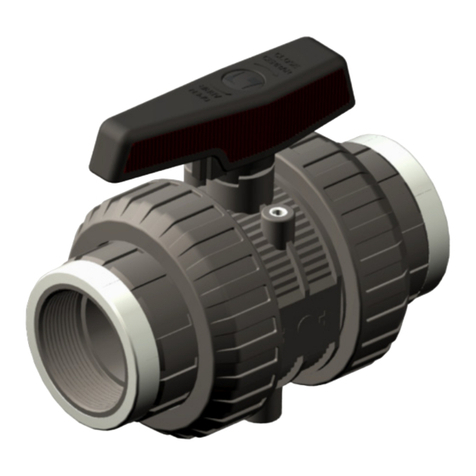
Cepex
Cepex PVC-U Installation and maintenance instructions
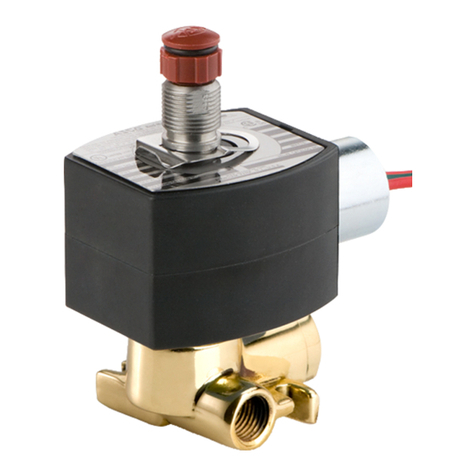
Asco
Asco 8317 Series Installation & maintenance instructions
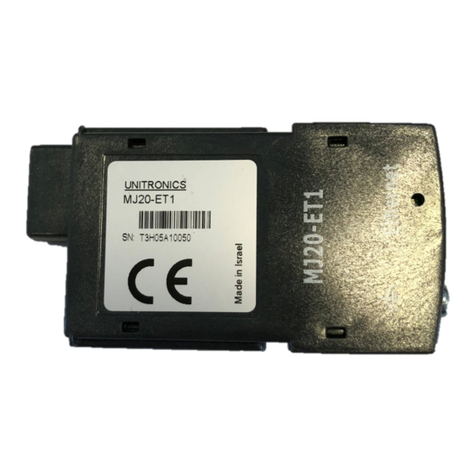
Unitronics
Unitronics MJ20-ET1 quick start guide
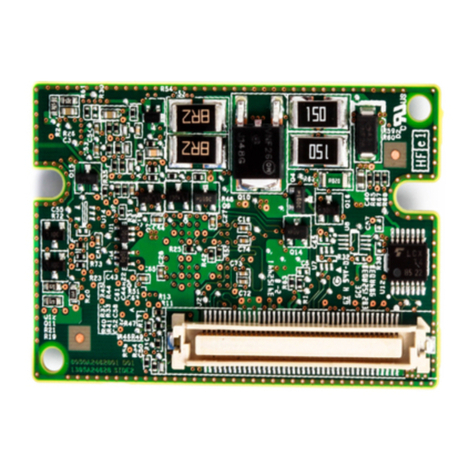
Broadcom
Broadcom CVPM02 user guide

Directed Perception
Directed Perception PTU-D46 Series user manual
